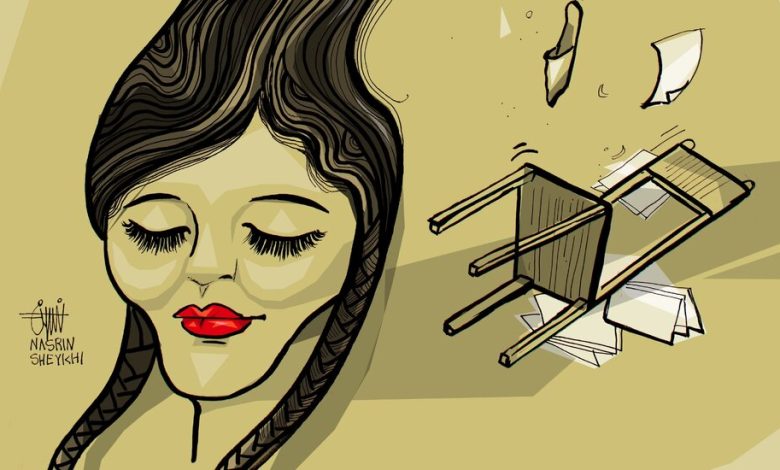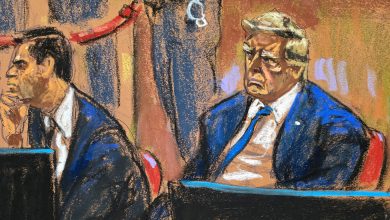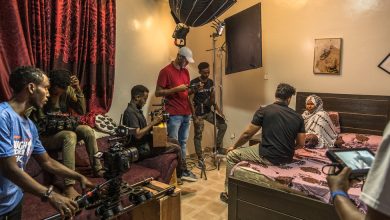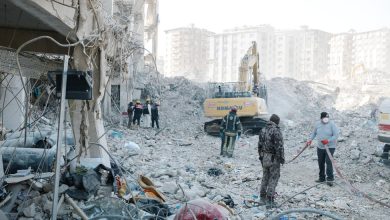Crisis in Iran Inspires a Cartoonist in New York

Good morning. It’s Friday. We’ll look at how a cartoonist who came to the United States from Iran responded to an episode that prompted nationwide protests there. We’ll also see what changes in admissions policies will mean for some New York middle schools and high schools.

Credit…Nasrin Sheykhi
Mahsa Amini’s story sent thousands of women into the streets in Iran. It sent Nasrin Sheykhi to the drawing board.
Amini was the 22-year-old woman who died in the custody of Iran’s morality police. Sheykhi is a cartoonist who left Iran five years ago. Last week, after wrapping up a show in New York, she produced caricatures showing Amini’s hair choking Ebrahim Raisi, the president of Iran.
“I came from the same generation that is fighting in the streets now,” said Sheykhi, 33. “I’m one of those women who was suffering from the Islamic regime laws.” Amini became a symbol of long-simmering anger over religious laws after the morality police arrested her, saying she had failed to cover her hair sufficiently, a violation of dress codes dictating modesty for women.
The protests continued this week, with women burning their head coverings and security forces firing on demonstrators with gunshots and water cannons as the government cracked down. As Sheykhi discovered as she tried to reach friends in Iran, cellphone and internet usage were drastically restricted.
In 43 years since coming to power, Sheykhi said, “the Islamic regime government has been trying to control women and put them as a second-class people, as if they have no rights for their own lives.” She said the pressure from the government was “like the pressure for making a diamond,” but Amini’s death in custody had been a tipping point for Iranians afraid to join past protests.
Sheykhi had chafed at the Iranian government’s increasingly tight grip on both women and freedom of expression long before she left. As a college student, a gallery manager told her it was illegal to show paintings of women that she had done.
I met Sheykhi in 2018, after the Trump administration had issued a ban on travel from several predominantly Muslim countries. She had received what is known as an “Einstein visa” — officially an EB-1A visa, the type that often goes to well-known people with what immigration officials consider “extraordinary ability” in fields like science, education or the arts. Sheykhi had taken some of the government’s terminology and used it in the title of an exhibition at a gallery in SoHo in 2018: “Alien of Extraordinary Ability: the EB-1A Tour.”
She told me this week that she had prepared an exhibition in Peekskill, N.Y., for women’s history month in March 2020 — unfortunate timing, she said: “I didn’t know Covid was going to make this world as silent as it has ever been.”
She moved several times to save on rent, but with galleries still closed, she decided she needed a job, any job. She ended up applying to Amazon and working at a huge warehouse.
“I could pay my bills and have my insurance,” she said. “During the pandemic they paid better than before because they needed us more than ever, but the job was meant for robots, not humans.”
That led to a revelation, she said: “I actually could handle the most difficult job in the U.S.A., so I can handle the rest of this life.”
She said she had posted social media images of art she had done since taking the Amazon job. She said one of her social-media followers told her: “If Jeff Bezos knew he had such a talented artist working for him, he’d start investing in your art.”
Weather
It’s a mostly cloudy day near the mid-60s. At night, prepare for a chance of rain with temps around the high 50s.
ALTERNATE-SIDE PARKING
In effect until Wednesday (Yom Kippur).
The latest New York news
-
Guilty plea: The electric-scooter rider who struck the actress Lisa Banes in a hit-and-run accident on the Upper West Side pleaded guilty to manslaughter and leaving the scene of an accident.
-
Redlining settlement: Lakeland Bank in New Jersey, accused by the Justice Department of redlining, agreed to create a $12 million homeownership fund, in one of the largest federal settlements of its kind.
Aaron Judge
-
The road to No. 61: Aaron Judge went seven games without a home run and admitted that the chase for No. 61 wore on him. Now he’s ready for more.
-
Chasing the profits: There is money to be made from Judge’s chase for home run history — for him, for the Yankees and for others.
Changing admissions rules for some selective public schools
The city loosened the criteria for admission to selective middle schools during the pandemic, a change some parents complained was unfair and others hoped would reduce racial disparities. Now it’s tightening them again.
Middle schools can once again use grades and test scores to decide which students to admit. Selective high schools will also be able to prioritize top-performing students in a shift away from policies adopted when Bill de Blasio was mayor, which brought more low-income students into some of the city’s most elite public schools.
Now the random lottery for middle schools will end. At competitive high schools, where de Blasio’s changes widened the pool of eligible applicants, students with A averages will have priority. The lotteries drew criticism from Asian American parents, among others, who said their children lost out on opportunities they had worked hard for.
But Black and Latino students are underrepresented at selective schools, and my colleague Troy Closson writes that some parents had hoped that de Blasio’s changes would be made permanent as a way of accelerating integration. (The changes did not apply to nine specialized high schools, including Stuyvesant High School, the Bronx High School of Science and Brooklyn Technical High School, and the latest shifts will not affect them.)
David Banks, who became schools chancellor after Mayor Eric Adams succeeded de Blasio at the beginning of the year, said that rolling back the previous administration’s policies would increase access for “communities who have been historically locked out of screened schools” while rewarding students who did well academically.
“It’s critically important that if you’re working hard and making good grades, you should not be thrown into a lottery with just everybody,” Banks said.
Banks’s announcement came as the city’s education officials face several crises. Standardized state test scores released on Wednesday showed that many students had fallen behind during the pandemic, particularly in math, and that many Hispanic, Black and low-income students continue to trail their white, Asian and higher-income peers. And enrollment is dropping: Roughly 120,000 families have left traditional public schools in the city over the past five years.
About a quarter of the city’s roughly 400 high schools that use admissions screens were allowed to consider metrics like grades through the pandemic. But state test results were not factored in, and other changes meant that students who made B’s were grouped in a pool with those who made A’s. That made each student’s lottery number much more important.
Now, students with A averages in the top 15 percent of their school — or across the city — will be given priority for seats, but state tests will not be considered.
“This is a threshold of excellence,” Banks said, adding that he does “not accept the notion” that “Black and Latino students do not score above 90.”
METROPOLITAN diary
Long way around
Dear Diary:
I was driving my daughter Lorraine to J.F.K. for a flight home to Nashville. We left Brooklyn at around 1 p.m. and took the Belt Parkway.
As we pulled up to the terminal, she got a text saying her flight had been canceled. I began the drive home as she negotiated frantically with the airline.
There was a 9 p.m. flight out of Kennedy, but it was booked solid. With apologies, the airline representative booked Lorraine a seat on a flight the next morning.
Disappointed, Lorraine noticed that the airline also flew to Nashville from La Guardia and Newark. She asked to be placed on one of those flights. Sure enough, just as I found a parking spot near home, she was booked on a 5:40 p.m. flight out of Newark.
We headed for the Verrazzano, went over it and through Staten Island, crossed the Goethals Bridge and got on the New Jersey Turnpike.
Approaching the airport exit, I asked Lorraine which terminal she needed.
“Oh, no!” she blurted out while scrolling through her text messages. “My flight is out of La Guardia!”
We got back on the turnpike, crossed the Newark Bay Bridge and made our way to the Holland Tunnel. We took that into Manhattan, drove across Canal Street, went over the Manhattan Bridge into Brooklyn, got on the B.Q.E. and took that across the Kosciuszko into Queens.
Finally, I dropped her at Terminal C at La Guardia.
“Look at it this way, Mom,” Lorraine said with a grin. “You get to brag that you traveled across five bridges, through four boroughs, to three airports in two states — and one tunnel.”
— Eileen Tynion
Illustrated by Agnes Lee. Send submissions here and read more Metropolitan Diary here.
Glad we could get together here. See you on Monday. — J.B.
P.S. Here’s today’s Mini Crossword and Spelling Bee. You can find all our puzzles here.
Melissa Guerrero and Ed Shanahan contributed to New York Today. You can reach the team at [email protected].
.




